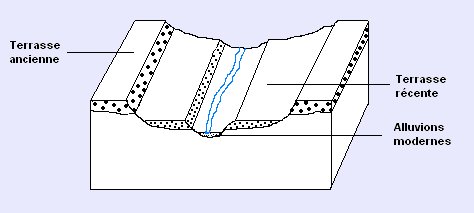
The weak vegetation lead to an important erosion.
The river spreads on the plateau and deposits alluviums.
The alluvion is superior to the transport.
 |
The flow's differences from a season to the other one are important (strong spring debacles).
The weak vegetation lead to an important erosion. The river spreads on the plateau and deposits alluviums. The alluvion is superior to the transport. |
 |
The flow's differences from a season to the other one are weak.
The strong vegetation protects the grounds of the erosion. The flows are too weak and don't permit the deposit of alluviums. The river digs its bed during the rare periods of strong currents, in its previous alluviums then in the underlying formations. The transport is superior to the alluvion. |
 |
Important differences of flow from a season to the other one, small vegetation, strong erosion and breakdown of rocks by the action of the frost/thaw.
The river widens its bed and deposits alluviums. The alluvion is superior to the transport. |
 |
The river digs its bed.
Final stage: formations of interlocked terraces, the highest topographically being the most ancient. |